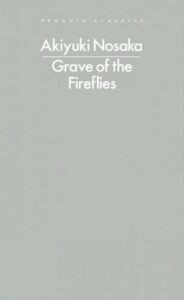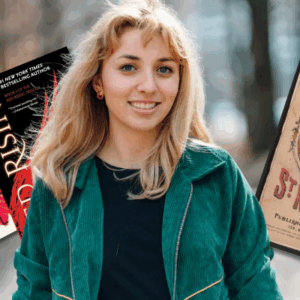
A New Translation of Grave of the Fireflies Commemorates 80 Years Since the End of WWII
Ginny Tapley Takemori on the Realities of War and Translating for a New Audience
Grave of the Fireflies was first published in 1967 in the magazine All Yomimono, and together with “American Hijiki” won Akiyuki Nosaka the prestigious Naoki Prize in 1967. The two stories along with four more were published in a collection in 1968. Grave of the Fireflies is probably the closest Nosaka came to writing about his own experience of the Kobe fire bombing of June 1945.
While many elements of the story are autobiographical, there are significant differences, the most important being that his protagonist, Seita, was an idealized character who acted far more nobly and cared much better for his little sister than Nosaka himself had been capable of. The lives of the two children in the story, aged fourteen and four, are portrayed as being as fleeting as the fireflies, and the story is an unsentimental and unflinching account with moments of both tenderness and heartlessness.
Nosaka always regretted not caring better for his own sister, who was just sixteen months old when she died. He blamed himself, as he didn’t share food with her, and he wrote the story to atone for her death and give repose to her soul. Of course, unlike Seita, he survived and went on to become a prolific author, singer, TV personality—and even politician—before his death in 2015.
The style, deliberately not easy to read even for Japanese readers, is an important element of the story.
The story was written at a time when the effects of the war were still very much in evidence, but people were moving on and trying to forget, working hard to pull the country out of poverty while beginning to see the economy heating up. It is written in an almost stream-of-consciousness style, rather like someone reluctantly dredging up their memories, with random thoughts interrupting the narrative, long sentences sometimes running to over a page, little punctuation, and peppered with Kobe dialect. The style, deliberately not easy to read even for Japanese readers, is an important element of the story.
However, given that James R. Abrams has already tried to capture the style and dialect in his translation published in the Japan Quarterly in 1978, which is still available to read online for anyone interested, I felt there was little point in taking a similar approach with my retranslation. Furthermore, readers of this new translation are in a time and space that is far removed from when the story was written, and many will have already seen the Ghibli animated film directed by Isao Takahata, which was released in 1988 and is currently streaming on Netflix.
Instead of letting the sentences run on and on, therefore, I have sometimes broken them up to make it easier to follow the trains of thought, while attempting to maintain the breathlessness and confusion of the original. And rather than attempt to reflect the dialect, I have simply tried to capture the voices of the children and the various adults around them.
I hope it serves as a timely reminder of the grim reality of war, a terrible fate that can befall anyone and should be avoided at all cost.
Interestingly, the penultimate paragraph of the original story was left out of the final published version, perhaps because one of the Naoki Prize judges had considered it somewhat old-fashioned.
その夜、布引の谷あいの螢、無数にとび立ち、 一筋の流れとなり、三宮駅浜側の夏草のしげ みに流れおち、くさむら一面無数の螢火にかざ られたという、うち捨てられた節子の骨を、守る ようにあやすようにあやすように。
That night, countless fireflies flew up from Nunobiki valley and formed a single stream that flowed down into the thicket of weeds outside the bayside exit of Sannomiya Station, covering the area where Setsuko’s bones had been thrown away as though to protect and comfort her, comfort her.
The date of Seita’s cremation was added to the final paragraph, which focuses in on Seita as one of many nameless war orphans who were cremated en masse and stored in temples as “abandoned souls.” This paragraph contains two terms that are very rooted in Japanese culture and hard to encapsulate in English: 野田 れ死ぬ (notarejinu ), which is quite a derogatory term, akin to “a dog’s death,” and 無縁仏 (muen botoke ), which refers to someone who dies with no living relatives or friends to lay them to rest and pray for their soul, meaning their soul can never rest in peace or attain salvation.
Nosaka’s use of these terms could be interpreted as emphasizing the futility of Seita’s death, and possibly justifying—or at least explaining—his own behavior. He himself referred to the story as being in the tradition of 心中 (shinjū ), or lovers’ suicide, by which he seemed to mean that the moment Seita took the decision to leave the widow’s house and live alone with Setsuko, their fate as outcasts was sealed. While everyone was busy working together trying to survive, and then rebuilding their lives afterwards, Seita and Setsuko cut themselves off and were left behind, denied access to any benefits from society, with no one to look out for them. It’s all very well being noble and pure, like Seita, but what’s the point when you are doomed to die an ignominious death and never rest in peace?
This new translation of Grave of the Fireflies is being published to commemorate, in September 2025, eighty years since the end of the Second World War, the war that was supposed to end all wars. While working on it, I have been hyper-aware of the fact that, like Seita and Setsuko, many innocent children are still suffering terrible neglect and dying ignominious deaths in numerous conflicts around the world, as well as the fact that we seem to be on the verge of a third world war. I hope it serves as a timely reminder of the grim reality of war, a terrible fate that can befall anyone and should be avoided at all cost. The remaining stories will be translated and released in the first full English translation of Nosaka’s original collection in a few years’ time.
__________________________________

Grave of the Fireflies by Akiyuki Nosaka and translated by Ginny Tapley Takemori is published by Penguin Classics on September 4, 2025.
Ginny Tapley Takemori
Ginny Tapley Takemori lives in rural Japan and has translated fiction by more than a dozen early modern and contemporary Japanese writers, ranging from such early literary giants as Izumi Kyoka and Okamoto Kido, to contemporary bestsellers Ryu Murakami and Miyabe Miyuki.



















